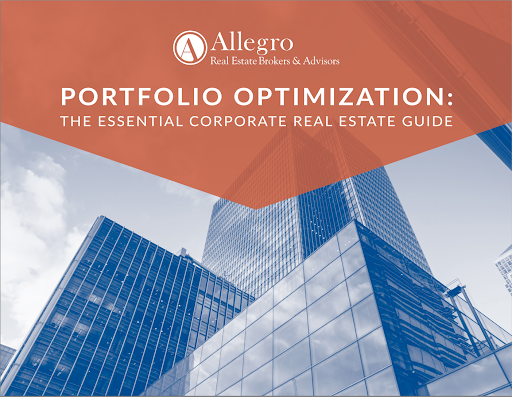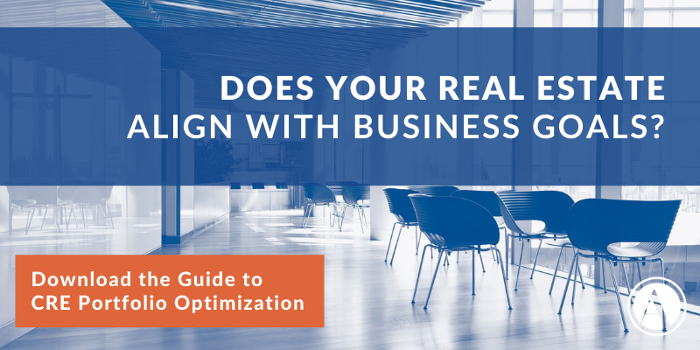Portfolio optimization—the process of evaluating real estate assets and operations to identify efficiencies, reduce costs, create a strategy, and maximize value—is critical for companies with CRE portfolios. As market conditions and business objectives can and often do change, organizations must remain aware of how both internal and external shifts impact their portfolios—and their bottom line.
It is always in a company’s best interest to ensure that their real estate portfolio supports overall business strategy; some commercial real estate properties that were once advantageous may no longer benefit your company.
To effectively evaluate all commercial real estate assets within your portfolio, and compare these findings against your business objectives, we recommend following the portfolio optimization process. Portfolio optimization ensures that every aspect of your evaluation receives the attention it deserves, and you come away with a lucid understanding of how each property within your CRE portfolio benefits (or does not benefit) your business objectives.
For everything you need to know about portfolio optimization, download our free whitepaper.
What is the Portfolio Optimization Process?
The portfolio optimization process involves a step-by-step comprehensive evaluation of assets, followed by actionable recommendations to implement change. Below are the four phases of CRE portfolio optimization.
Current State Assessment
The first step of the portfolio optimization process is conducting a current state assessment to identify all supportive, unsupportive, and missing (gaps) assets in your real estate portfolio, while also evaluating the people, processes, and technology that impact your CRE. There are two objectives of this first phase: understand your assets, liabilities, and opportunities, and establish the baseline for all cost savings.
The current state assessment may include tasks like:
- Reviewing owned and leased properties to identify opportunities, liabilities, and any missing data.
- Conducting a lease and asset valuation for your real estate portfolio.
- Identifying existing policies and internal processes.
- Understanding current tools and technologies.
Tools like performance benchmarks, a utilization model of your CRE portfolio, and a baseline financial model will help guide an accurate assessment of your existing assets.
Future State Assessment
In the second phase of portfolio optimization, future state assessment, we articulate future real estate needs for the organization.
The future state assessment phase typically includes the following tasks:
- Conducting interviews with real estate and business unit leaders.
- Distributing surveys to understand existing assets and future real estate needs.
- Identifying and interviewing peer organizations to develop case studies of best practices.
When partnering with a real estate broker, like Allegro Real Estate Brokers & Advisors, expect to come away from this second phase with a summary of your current and future KPIs and a best practice case study analysis.
Scenario Planning, Strategy & Action Plans
At this point in the portfolio optimization process, it’s time to evaluate multiple scenarios and develop a preferred strategy. Scenario modeling uses lease, occupancy costs, and forecasted space requirements to yield a strategy that makes the most sense for your business.
With input from your key real estate stakeholders, this strategy will encompass your future real estate needs and include action items for successful implementation.
A variety of deliverables are typically developed during this phase and may include:
- Portfolio scenario models.
- Short-, medium-, and long-term real estate goals.
- Decision making tree and accountability chart.
- Implementation plan.
- KPIs for real estate portfolio.
- Dashboards.
- Actionable plan for each property within the portfolio.
Implementation
While the majority of the work in the previous steps is widely project-based, the final implementation stage is more managerial in nature. In this phase, your real estate broker will work with you to manage strategic action items, financials, and transactions to guide the portfolio and realize business goals.
To effectively implement the strategy developed in the previous phases, expect support from your real estate broker in the form of bi-weekly tactical meetings, quarterly strategic meetings, and ongoing transaction management.
Having a clear understanding of your commercial real estate portfolio is an essential step in optimizing your overall business strategy. By knowing which properties in your portfolio are no longer advantageous, you can shed those unnecessary investments and hone in on the ones that move your business forward.
Align Your CRE Portfolio With Business Strategy
Corporate real estate optimization is fundamental to achieving your business goals and responding to new challenges. Learn more about assessing and adapting your CRE to meet changes in business by downloading our free guide, Portfolio Optimization: The Essential Corporate Real Estate Guide.








